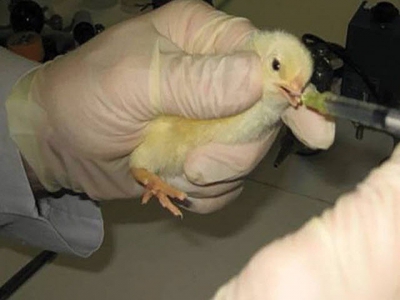Salmonella, Campylobacter infection routes in broilers

The pathogenic bacteria can spread through a number of bodily routes and infect a large portion of the flock if unchecked.
Inoculation of a day old chick by oral gavage. | U.S. National Poultry Research Center
Newly hatched broiler chicks can be exposed to significant levels of both Salmonella and Campylobacter in the hatching cabinet, the hatchery and the broiler house. Exposure of chicks to Salmonella and Campylobacter is critical because the bird lacks a mature gut microflora and is highly susceptible to colonization by the foodborne pathogens.
Microbes can enter chicks through an assortment of body openings: the mouth, nares, cloaca, eye and navel. Once bacteria reach the ceca they may colonize and multiply exponentially in a short time. At this point, the animal can become a seeder chick by excreting the bacteria in its cecal droppings and contaminating other birds in the broiler house.
Studying infection routes
These studies evaluated various possible routes of Salmonella or Campylobacter entry and looked to determine which would produce appreciable numbers in the ceca. In order to avoid confounding by natural contaminants, antimicrobial resistant marker strains of bacteria, a nalidixic acid resistant S. Typhimurium (ST) and a gentamicin resistant C. coli (Cc), were used.
Varying numbers of each organism were introduced to chicks by mouth, cloaca or dripping in the eye. Exposed chicks were housed in isolation units on wire mesh. Seven days post inoculation all chicks were humanely euthanized by cervical dislocation, surface disinfected with 70 percent ethanol and ceca aseptically removed and analyzed for the marker strain. Salmonella data are presented in Table 1; Campylobacter data are presented in Table 2.
Table 1: This table shows what percentage of day-old broiler chicks can be colonized by Salmonella from a variety of inoculation sites and the various levels of colonization from each site.

Table 2: This table shows what percentage of day-old broiler chicks can be colonized by Campylobacter from a variety of inoculation sites and the various levels of colonization from each site.

Experimental results
The results from these studies are similar. The oral, intracloacal and eye exposure routes resulted in high incidence of colonization and production of seeder birds. For the oral route, we were concerned that the acid pH of the proventriculus and gizzard. Previous research determined to be 1.9 and could kill inoculated bacteria.
Since early oral inoculation may be accompanied by ingestion of eggshell, an oral inoculation including 5 percent calcium carbonate was used to simulate the chemical content and possible buffering effect of eggshell. When CaCO3 was included, it did not increase the chances of a chick becoming colonized with ST but appeared to increase the chance a chick may be colonized with Cc. Campylobacter is a more fragile organism than Salmonella so it makes sense that is may be more sensitive to the acidity associated with oral inoculation.
Conclusion
These studies demonstrate that Salmonella and Campylobacter can contact and colonize the chick intestinal tract through an assortment of body openings. There is a definite potential for seeder birds to result from such contamination and spread bacteria in the broiler house. To prevent contamination of broilers and meat products with human pathogens, exposure of the young chick must be controlled.
References available upon request
Related news
 Lighting may help with poultry welfare issues
Lighting may help with poultry welfare issues Industry professional discusses the impact lighting has on cannibalism, skeletal injuries and piling
 Future of poultry welfare: What producers should expect
Future of poultry welfare: What producers should expect Attitudes to poultry welfare still vary greatly from market to market, but ever-more alignment can be expected as interest in animal welfare grows.
 How Thailand is fighting poultry disease with technology
How Thailand is fighting poultry disease with technology Community engagement and a clever phone app are helping to control poultry and other livestock diseases in Thailand.